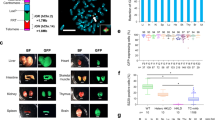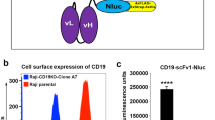Abstract
We report a flexible strategy for the high level expression of a recombinant human monoclonal antibody (mAb) in Chinese hamster ovary (CHO) cells, initially using COS monkey kidney cell transfections to evaluate rapidly modifications to immunoglobulin (Ig) DNA constructs. Using sequential transfections with two amplifiable markers, we generated CHO cell lines and clones that secrete 80–110 μg/106 cells/24 hours of a mousehuman chimeric IgG1κ mAb. This cellular productivity is considerably greater than most murine hybridomas and transfected myelomas. Our data also demonstrate that genomic kappa sequences can improve mAb expression in COS and CHO cells. As a paradigm, we focused our expression studies on a human chimeric form of 3F8, a murine mAb that binds to ganglioside GD2 on neuroblastoma and melanoma tumor cells.
This is a preview of subscription content, access via your institution
Access options
Subscribe to this journal
Receive 12 print issues and online access
$209.00 per year
only $17.42 per issue
Buy this article
- Purchase on Springer Link
- Instant access to full article PDF
Prices may be subject to local taxes which are calculated during checkout
Similar content being viewed by others
References
Waldmann, T.A. 1991. Monoclonal antibodies in diagnosis and therapy. Science 252: 1657–1662.
Chatenoud, L., Baudrihaye, M.F., Chkoff, N., Kreis, H., Goldstein, G. and Bach, J.-F. 1986. Restriction of the human in vivo immune response against the mouse monoclonal antibody OKT3. J. Immunol. 137: 830–838.
Khazaeli, M.B., Saleh, M.N., Wheeler, R.H., Huster, W.J., Holden, H., Carrano, R. and LoBuglio, A. 1988. Phase I trial of multiple large doses of murine monoclonal antibody CO17-1A. II. Pharmacokinetics and Immune Response. J. Natl. Cancer Inst. 80: 937–942.
Morell, A., Terry, W.D. and Waldman, T.A. 1970. Metabolic properties of IgG subclasses in man. J. of Clinical Investigation 49: 673–680.
Ortaldo, R., Woodhouse, C., Morgan, A.C., Herberman, R.B., Cheresh, D.A. and Reisfeld, R. 1987. Analysis of effector cells in human antibody-dependent cellular cytotoxicity with murine monoclonal antibodies. J. Immunol. 138: 3566–3572.
Winter, G. and Milstein, C. 1991. Man-made antibodies. Nature 349: 293–299.
Morrison, S.L. 1992. In vitro antibodies: strategies for production and application. Annu. Rev. Immunol. 10: 239–265.
Hale, G., Dyer, M.J.S., Clark, M.R., Phillips, J.M., Marcus, R., Riechmann, L., Winter, G. and Waldmann, H. 1988. Remission induction in non-hodgkin lymphoma with reshaped human monoclonal antibody CAMPATH-1H. Lancet 2: 1394–1399.
LoBuglio, A.F., Wheeler, R.H., Trang, J., Haynes, A., Rogers, K., Harvey, E.B., Sun, L., Ghrayeb, J. and Khazaeli, M.B. 1989. Mouse/human chimeric monoclonal antibody in man: kinetics and immune response. Proc. Natl. Acad. Sci. USA 86: 4220–4224.
Boerner, P., Lafond, R., Lu, W., Brams, P. and Royston, I. 1991. Production of antigen-specific human monoclonal antibodies from in vitro-primed human splenocytes. J. Immunol. 147: 86–95.
Marks, J.D., Hoogenboom, H.R., Bonnert, T.P., McCafferty, J., Griffiths, A.D. and Winter, G. 1991. By-passing immunization, human antibodies from V-gene libraries displayed on phage. J. Mol. Biol. 222: 581–597.
Kang, A.S., Barbas, C.F., Janda, K.D., Benkovic, S.J. and Lerner, R.A. 1991. Linkage of recognition and replication functions by assembling combinatorial antibody Fab libraries along phage surfaces. Proc. Natl. Acad. Sci. USA 88: 4363–4366.
Bebbington, C.R., Renner, G., Thomson, S., King, D., Abrams, D. and Yarranton, G.T. 1992. High-level expression of a recombinant antibody from myeloma cells using a glutamine synthase gene as an amplifiable selectable marker. Bio/Technology 10: 169–175.
Page, M.J. and Sydenham, M.A. 1991. High level expression of the humanized monoclonal antibody CAMPATH-1H in Chinese hamster ovary cells. Bio/Technology 9: 65–68.
Wood, C.R., Dorner, A.J., Morris, G.E., Alderman, E.M., Wilson, D., O'Hara, R.M. Jr. and Kaufman, R.J. 1990. High level synthesis of immunoglobulins in Chinese hamster ovary cells. J. Immunol. 145: 3011–3016.
Saito, M., Yu, R.K. and Cheung, N.-K.V. 1985. Ganglioside GD2 specificity of monoclonal antibodies to human neuroblastoma cell. Biochem. Biophys. Res. Commun. 127: 1–7.
Cheung, N.-K.V., Lazarus, H., Miraldi, F.D., Abramowsky, C.R., Kallick, S., Sarrinen, U.M., Spitzer, T., Strandjord, S.E., Coccia, P.F. and Berger, N.A. 1987. Ganglioside GD2 specific monoclonal antibody 3F8: a phase I study in patients with neuroblastoma and malignant melanoma. J. Clin. Oncol. 5: 1430–1440.
Cheung, N.-K.V., Lazarus, H., Miraldi, F.D., Berger, N.A., Abramowsky, C.R., Saarinen, U.M., Spitzer, T., Spitzer, T., Strandjord, S.E. and Coccia, P.F. 1992. Reassessment of patient response to monoclonal antibody 3F8. J. Clin. Oncol. 10: 671–672.
Wu, Z-L., Schwartz, E., Seeger, R. and Ladisch, S. 1986. Expression of GD2 ganglioside by untreated primary human neuroblastomas. Cancer Res. 46: 440–443.
Berd, D., Herlyn, M., Koprowski, H. and Mastrangelo, M. 1989. Flow cytometric determination of the frequency and heterogeneity of expression of human melanoma-associated antigens. Cancer Res. 49: 6840–6844.
Cheresh, D., Rosenberg, J., Mujoo, K., Hirschowitz, L. and Reisfeld, R. 1986. Biosynthesis and expression of the disialoganglioside GD2, a relevant target antigen on small cell lung carcinoma for monoclonal antibody-mediated cytolysis. Cancer Res. 46: 5112–5188.
Heiner, J., Miraldi, F., Kallick, S., Makley, J., Neely, J., Smith-Mensah, W.H. and Cheung, N.-K.V. 1987. Localization of GD2-specific monoclonal antibody, 3F8 in human osteosarcoma. Cancer Res. 47: 5377–5381.
Saarinen, U.M., Coccia, P.F., Gerson, S.L., Pelley, R. and Cheung, N.-K.V. 1985. Eradication of neuroblastoma cells in vitro by monoclonal antibody and human complement: method for purging autologous bone marrow. Cancer Res. 45: 5969–5975.
Kushner, B.H. and Cheung, N.-K.V. 1989. GM-CSF enhances 3F8 monoclonal antibody-dependent cellular cytotoxicity against human melanoma and neuroblastoma. Blood 73: 1936–1941.
Munn, D.H. and Cheung, N.-K.V. 1987. Interleukin-2 enhancement of monoclonal antibody-mediated cellular cytotoxicity against human melanoma. Cancer Res. 47: 6600–6605.
Munn, D.H. and Cheung, N.-K.V. 1989. Antibody-dependent antitumor cytotoxicity by human monocytes cultured with recombinant macrophage colony-stimulating factor. J. Exp. Med. 170: 511–526.
Munn, D.H. and Cheung, N.-K.V. 1990. Phagocytosis of tumor cells by human monocytes cultured in recombinant macrophage colony-stimulating factor. J. Exp. Med. 172: 231–237.
Harlow, E. and Lane, D. 1988. Antibodies, A Laboratory Manual. Cold Spring Harbor Laboratory Press, Cold Spring Harbor, NY.
Kaufman, R.J. 1988. Selection and coamplification of heterologous genes in mammalian cells. Methods in Enzymol. 185: 537–566.
Bruggemann, M., Williams, G.T., Bindon, C.I., Clark, M.R., Walker, M.R., Jefferis, R., Waldmann, H. and Neuberger, M.S. 1987. Comparison of the effector functions of human immunoglobulins using a matched set of chimeric antibodies. J. Exp. Med. 166: 1351–1361.
Steplewski, Z., Sun, L.K., Shearman, C.W., Ghrayeb, J., Daddona, P. and Koprowski, H. 1988. Biological activity of human-mouse IgG1, IgG2, IgG3, and IgG4 chimeric monoclonal antibodies with antitumor specificity. Proc. Natl. Acad. Sci. USA 85: 4852–4856.
Shaw, D., Khazeli, M.B. and LoBuglio, A.F. 1988. Mouse/human chimeric antibodies to a tumor-associated antigen: biologic activity of the four human IgG subclasses. J. Nat. Can. Inst. 80: 1553–1559.
Hendershot, L., Bole, D. and Kearney, J.F. 1987. The role of immunoglobulin heavy chain binding protein in immunoglobulin transport. Immunol. Today 8: 111–114.
Fasler, S., Skvaril, F. and Lutz, H.U. 1988. Electrophoretic properties of human IgG and its subclasses on sodium dodecyl-sulfate-polyacrylamide gel electrophoresis and immunoblots. Anal. Biochem. 174: 593–600.
Riboni, L., Sonnino, S., Acquotti, D., Malesci, A., Ghidoni, R., Egge, H., Mingrino, S. and Tettamanti, G. 1986. Natural occurrence of ganglioside lactones. J. Biol. Chem. 261: 8514–8519.
Emorine, L., Kuehl, M., Weir, L., Leder, P. and Max, E.E. 1983. A conserved sequence in the immunoglobulin Jκ-Cκ intron: possible enhancer element. Nature 304: 447–449.
Larrick, J.W. and Fry, K.E. 1991. Recombinant antibodies. Hum. Antibod. Hybridomas 2: 172–189.
Neuberger, M.S. and Williams, G.T. 1988. The intron requirement for immunoglobulin gene expression is dependent upon the promoter. Nucl. Acids. Res. 16: 6713–6724.
Buchman, A.R. and Berg, P. 1988. Comparison of intron-dependent and intron-independent gene expression. Mol. Cell. Biol. 8: 4395–4405.
Chung, S. and Perry, R.P. 1989. Importance of introns for expression of mouse ribosomal protein gene rpL32. Mol. Cell. Biol. 9: 2075–2082.
Ryu, W.-S. and Mertz, J.E. 1989. Simian virus 40 late transcripts lacking excisable intervening sequences are defective in both stability in the nucleus and transport to the cytoplasm. J. Virol. 63: 4386–4394.
Palmiter, R.D., Sandgren, E.P., Avarbock, M.R., Allen, D.D. and Brinster, R.L. 1991. Heterologous introns can enhance expression of transgenes in mice. Proc. Natl. Acad. Sci. USA 88: 478–482.
Shaw, G. and Kamen, R. 1986. A conserved AU sequence from the 3′ untranslated region of GM-CSF mRNA mediates selective mRNA degradation. Cell 46: 659–667.
Kozak, M. 1987. Effects of intercistronic length on the efficiency of reinitiation by eucaryotic ribosomes. Mol. Cell. Biol. 7: 3438–3445.
Daar, I.O. and Maquat, L.E. 1988. Premature translation termination mediates triosephosphate isomerase mRNA degradation. Mol. Cell. Biol. 8: 802–813.
Queen, C., Schneider, W.P., Selick, H.E., Payne, P.W., Landolfi, N.F., Duncan, J.F., Avdalovic, N.M., Levitt, M., Junghans, R.P. and Waldmann, T.A. 1989. A humanized antibody that binds to the interleukin 2 receptor. Proc. Natl. Acad. Sci. USA 86: 10029–10033.
Shearman, C.W., Pollock, D., White, G., Hehir, K., Moore, G.P., Kanzy, E.J. and Kurrle, R. 1991. Construction, expression and characterization of humanized antibodies directed against the human α/β T cell receptor. J. Immunol. 147: 4366–4373.
Maeda, H., Matsushita, S., Eda, Y., Kimachi, K., Tokiyoshi, S. and Bendig, M.M. 1991. Construction of reshaped human antibodies with HIV-neutralizing activity. Hum. Antibod. Hybridomas 2: 124–134.
Maniatis, T., Fritsch, E.F. and Sambrook, J 1982. Molecular Cloning, A Laboratory Manual. Cold Spring Harbor Laboratory Press, Cold Spring Harbor, NY
Saiki, R.K., Gelfand, D.H., Stoffel, S., Scharf, S.J., Higuchi, R., Horn, G.T., Mullis, K.B. and Erlich, H.A. 1988. Primer-directed enzymatic amplification of DNA with a thermostable DNA polymerase. Science 239: 487–491.
Sambrook, J., Fritsch, E.F. and Maniatis, T. 1989. Molecular Cloning, A Laboratory Manual. Second Edition. Cold Spring Harbor Laboratory Press, Cold Spring Harbor, NY.
Hieter, P.A., Max, E.E., Seidman, J.G., Maizel, J.V. Jr. and Leder, P. 1980. Cloned human and mouse kappa immunoglobulin constant and J region genes conserve homology in functional segments. Cell 22: 197–207.
Ellison, J.W., Berson, B.J. and Hood, L.E. 1982. The nucleotide sequence of a human immunoglobulin Cγ1 gene. Nucl. Acids Res. 10: 4071–4079.
Lopata, M.A., Cleveland, D.W. and Sollner-Webb, B. 1984. High level transient expression of a chloramphenicol acetyl transferase gene by DEAE-dextran mediated DNA transfection coupled with a dimethyl sulfoxide or glycerol shock treatment. Nucl. Acids Res. 12: 5707–5717.
Luthman, H. and Magnusson, G. 1983. High efficiency polyoma DNA transfection of chloroquine treated cells. Nucl. Acids Res. 11: 1295–1308.
Felgner, P.L., Gadek, T.R., Holm, M., Roman, R., Chan, H.W., Wenz, M., Northrop, J.P., Ringold, G.M. and Danielsen, M. 1987. Lipofection: A highly efficient, lipid-mediated DNA-transfection procedure. Proc. Natl. Acad. Sci. USA 84: 7413–7417.
Max, E.E., Maizel, J.V. Jr. and Leder, P. 1981. The nucleotide sequence of a 5.5•kilobase DNA segment containing the mouse κ immunoglobulin J and C region genes. J. Biol. Chem. 256: 5116–5120.
Dorner, A.J. and Kaufman, R.J. 1990. Analysis of synthesis, processing, and secretion of proteins expressed in mammalian cells. Methods In Enzymol. 185: 577–596.
Chaplin, M.F. 1986. Monosaccharides, p.6. In: Carbohydrate Analysis: A Practical Approach. Chaplin, M. F. and Kennedy, J. F. (Eds). IRL Press, Oxford, UK.
Morrison, I.M. 1986. Glycolipids, p. 208. In: Carbohydrate Analysis: A Practical Approach. Chaplin, M. F. and Kennedy, J. F. (Eds.). IRL Press, Oxford, UK.
Ledeen, R.W. 1989. Biosynthesis, metabolism and biological effects of gangliosides, p. 45. In: Neurobioloqy of Glycoconjugates. Margolis, R. U. and Margolis, R. K. (Eds.). Plenum Press, NY.
Author information
Authors and Affiliations
Rights and permissions
About this article
Cite this article
Fouser, L., Swanberg, S., Lin, BY. et al. High Level Expression of a Chimeric Anti–Ganglioside GD2 Antibody: Genomic Kappa Sequences Improve Expression in COS and CHO Cells. Nat Biotechnol 10, 1121–1127 (1992). https://doi.org/10.1038/nbt1092-1121
Received:
Accepted:
Issue Date:
DOI: https://doi.org/10.1038/nbt1092-1121



